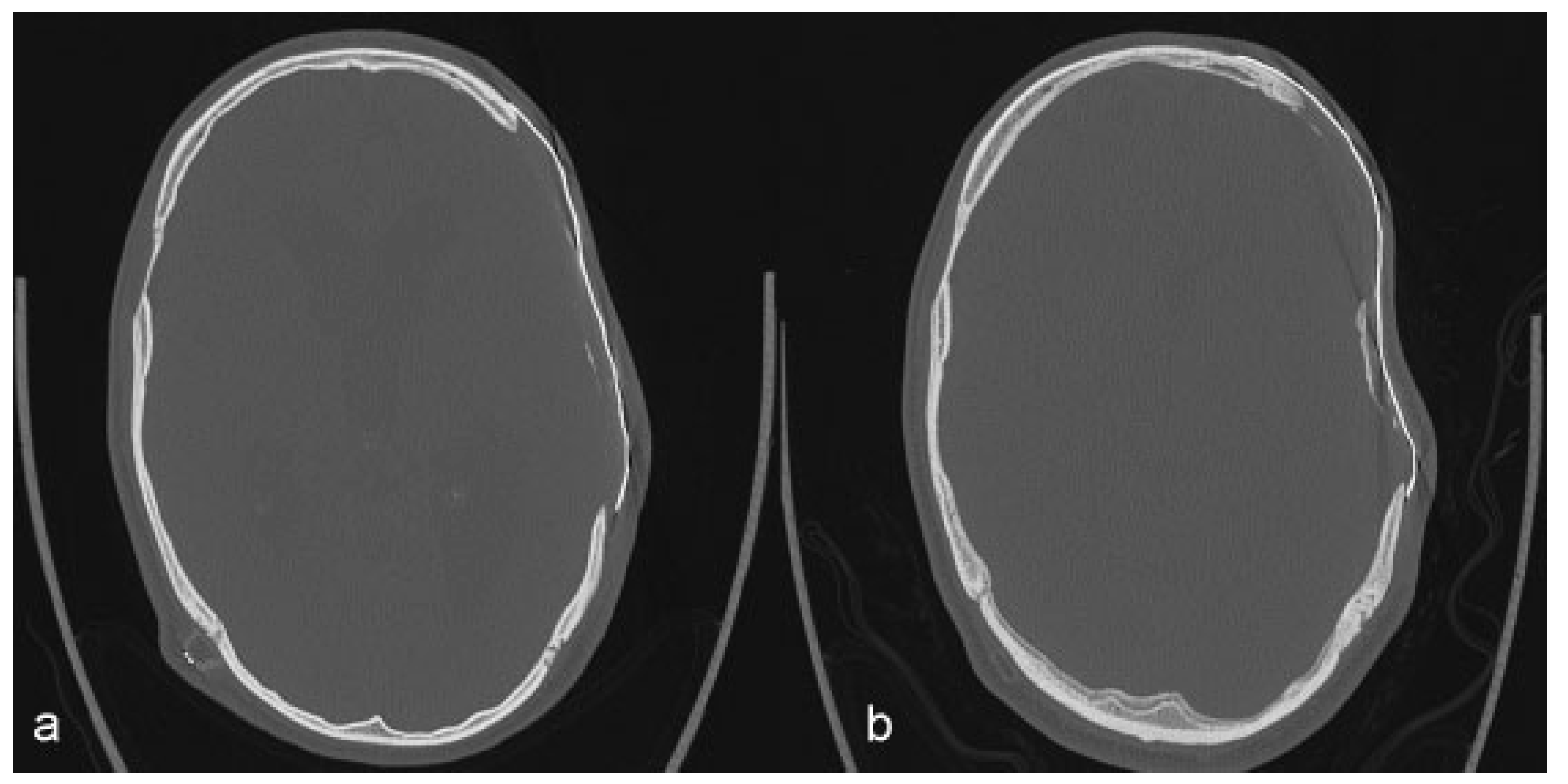Deformation of a Titanium Calvarial Implant following Trauma: A Case Report
Abstract
:References
- Honeybul, S.; Ho, K.M. Long-term complications of decompressive craniectomy for head injury. J Neurotrauma 2011, 28, 929–935. [Google Scholar] [CrossRef]
- Akins, P.T.; Guppy, K.H. Sinking skin flaps, paradoxical herniation, and external brain tamponade: a review of decompressive craniectomy management. Neurocrit Care 2008, 9, 269–276. [Google Scholar] [CrossRef] [PubMed]
- Dujovny, M.; Aviles, A.; Agner, C.; Fernandez, P.; Charbel, F.T. Cranioplasty: cosmetic or therapeutic? Surg Neurol 1997, 47, 238–241. [Google Scholar] [CrossRef] [PubMed]
- Honeybul, S. Complications of decompressive craniectomy for head injury. J Clin Neurosci 2010, 17, 430–435. [Google Scholar] [CrossRef] [PubMed]
- Grant, F.C.; Norcross, N.C. Repair of cranial defects by cranioplasty. Ann Surg 1939, 110, 488–512. [Google Scholar] [CrossRef]
- Ng, D.; Dan, N.G. Cranioplasty and the syndrome of the trephined. J Clin Neurosci 1997, 4, 346–348. [Google Scholar] [CrossRef]
- Fodstad, H.; Love, J.A.; Ekstedt, J.; Fridén, H.; Liliequist, B. Effect of cranioplasty on cerebrospinal fluid hydrodynamics in patients with the syndrome of the trephined. Acta Neurochir (Wien) 1984, 70, 21–30. [Google Scholar] [CrossRef]
- Liang, W.; Xiaofeng, Y.; Weiguo, L.; et al. Cranioplasty of large cranial defect at an early stage after decompressive craniectomy performed for severe head trauma. J Craniofac Surg 2007, 18, 526–532. [Google Scholar] [CrossRef]
- Spetzger, U.; Vougioukas, V.; Schipper, J. Materials and techniques for osseous skull reconstruction. Minim Invasive Ther Allied Technol 2010, 19, 110–121. [Google Scholar] [CrossRef]
- Sahoo, N.; Roy, I.D.; Desai, A.P.; Gupta, V. Comparative evaluation of autogenous calvarial bone graft and alloplastic materials for secondary reconstruction of cranial defects. J Craniofac Surg 2010, 21, 79–82. [Google Scholar] [CrossRef]
- Laure, B.; Geais, L.; Tranquart, F.; Goga, D. Mechanical characterization and optoelectronic measurement of parietal bone thickness before and after monocortical bone graft harvest: design and validation of a test protocol. J Craniofac Surg 2011, 22, 113–117. [Google Scholar] [CrossRef] [PubMed]
- Goldstein, J.A.; Paliga, J.T.; Bartlett, S.P. Cranioplasty: indications and advances. Curr Opin Otolaryngol Head Neck Surg 2013, 21, 400–409. [Google Scholar] [CrossRef] [PubMed]
- Jaberi, J.; Gambrell, K.; Tiwana, P.; Madden, C.; Finn, R. Long-term clinical outcome analysis of poly-methyl-methacrylate cranioplasty for large skull defects. J Oral Maxillofac Surg 2013, 71, e81–e88. [Google Scholar] [CrossRef] [PubMed]
- Marchac, D.; Greensmith, A. Long-term experience with methylmethacrylate cranioplasty in craniofacial surgery. J Plast Reconstr Aesthet Surg 2008, 61, 744–752, discussion 753. [Google Scholar] [CrossRef]
- Cabraja, M.; Klein, M.; Lehmann, T.N. Long-term results following titanium cranioplasty of large skull defects. Neurosurg Focus 2009, 26, E10. [Google Scholar] [CrossRef]
- Petridis, A.K.; Barth, H.; Doukas, A.; Mehdorn, H.M. Broken bioceramic used in a computer-assisted reconstruction of the frontal skull bone. J Clin Neurosci 2009, 16, 1089–1090. [Google Scholar] [CrossRef]
- Matic, D.B.; Manson, P.N. Biomechanical analysis of hydroxyapatite cement cranioplasty. J Craniofac Surg 2004, 15, 415–422, discussion 422–423. [Google Scholar] [CrossRef]
- Miller, L.; Guerra, A.B.; Bidros, R.S.; Trahan, C.; Baratta, R.; Metzinger, S.E. A comparison of resistance to fracture among four commercially available forms of hydroxyapatite cement. Ann Plast Surg 2005, 55, 87–92, discussion 93. [Google Scholar] [CrossRef]
- Stefini, R.; Esposito, G.; Zanotti, B.; Iaccarino, C.; Fontanella, M.M.; Servadei, F. Use of “custom made” porous hydroxyapatite implants for cranioplasty: postoperative analysis of complications in 1549 patients. Surg Neurol Int 2013, 4, 12. [Google Scholar] [CrossRef]
- Staffa, G.; Barbanera, A.; Faiola, A.; et al. Custom made bioceramic implants in complex and large cranial reconstruction: a two-year follow-up. J Craniomaxillofac Surg 2012, 40, e65–e70. [Google Scholar] [CrossRef]
- Eppley, B.L. Biomechanical testing of alloplastic PMMA cranioplasty materials. J Craniofac Surg 2005, 16, 140–143. [Google Scholar] [CrossRef] [PubMed]
- Ko, A.L.; Nerva, J.D.; Chang, J.J.; Chesnut, R.M. Traumatic fracture of polymethylmethacrylate patient-specific cranioplasty implant. World Neurosurg 2013, 82, 536.e11–536.e13. [Google Scholar] [CrossRef] [PubMed]
- Tsouknidas, A.; Maropoulos, S.; Savvakis, S.; Michailidis, N. FEM assisted evaluation of PMMA and Ti6Al4V as materials for cranioplasty resulting mechanical behaviour and the neurocranial protection. Biomed Mater Eng 2011, 21, 139–147. [Google Scholar] [CrossRef]
- Lethaus, B.; Safi, Y.; ter Laak-Poort, M.; et al. Cranioplasty with customized titanium and PEEK implants in a mechanical stress model. J Neurotrauma 2012, 29, 1077–1083. [Google Scholar] [CrossRef]
- Wiggins, A.; Austerberry, R.; Morrison, D.; Ho, K.M.; Honeybul, S. Cranioplasty with custom-made titanium plates—14 years experience. Neurosurgery 2013, 72, 248–256, discussion 256. [Google Scholar] [CrossRef]
- Zhang, J.; Yoganandan, N.; Pintar, F.A. Dynamic biomechanics of the human head in lateral impacts. Ann Adv Automot Med 2009, 53, 249–256. [Google Scholar]




© 2015 by the author. The Author(s) 2015.
Share and Cite
De Water, V.R.; dos Santos Rubio, E.J.; Schouten, J.W.; Koudstaal, M.J. Deformation of a Titanium Calvarial Implant following Trauma: A Case Report. Craniomaxillofac. Trauma Reconstr. 2016, 9, 158-161. https://doi.org/10.1055/s-0035-1567810
De Water VR, dos Santos Rubio EJ, Schouten JW, Koudstaal MJ. Deformation of a Titanium Calvarial Implant following Trauma: A Case Report. Craniomaxillofacial Trauma & Reconstruction. 2016; 9(2):158-161. https://doi.org/10.1055/s-0035-1567810
Chicago/Turabian StyleDe Water, Valerie R., Ellianne J. dos Santos Rubio, Joost W. Schouten, and Maarten J. Koudstaal. 2016. "Deformation of a Titanium Calvarial Implant following Trauma: A Case Report" Craniomaxillofacial Trauma & Reconstruction 9, no. 2: 158-161. https://doi.org/10.1055/s-0035-1567810
APA StyleDe Water, V. R., dos Santos Rubio, E. J., Schouten, J. W., & Koudstaal, M. J. (2016). Deformation of a Titanium Calvarial Implant following Trauma: A Case Report. Craniomaxillofacial Trauma & Reconstruction, 9(2), 158-161. https://doi.org/10.1055/s-0035-1567810


